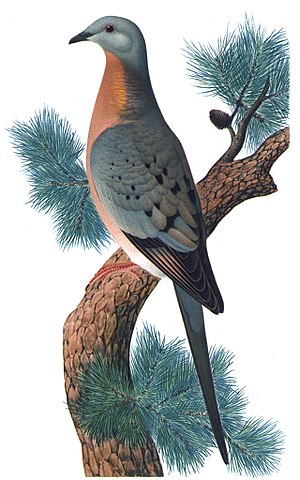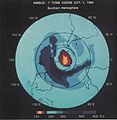Portal:Environment
Introduction The natural environment or natural world encompasses all living and non-living things occurring naturally, meaning in this case not artificial. The term is most often applied to Earth or some parts of Earth. This environment encompasses the interaction of all living species, climate, weather and natural resources that affect human survival and economic activity. The concept of the natural environment can be distinguished as components:
In contrast to the natural environment is the built environment. Built environments are where humans have fundamentally transformed landscapes such as urban settings and agricultural land conversion, the natural environment is greatly changed into a simplified human environment. Even acts which seem less extreme, such as building a mud hut or a photovoltaic system in the desert, the modified environment becomes an artificial one. Though many animals build things to provide a better environment for themselves, they are not human, hence beaver dams, and the works of mound-building termites, are thought of as natural. (Full article...)  The natural environment or natural world encompasses all living and non-living things occurring naturally, meaning in this case not artificial. The term is most often applied to Earth or some parts of Earth. This environment encompasses the interaction of all living species, climate, weather and natural resources that affect human survival and economic activity. The concept of the natural environment can be distinguished as components:
In contrast to the natural environment is the built environment. Built environments are where humans have fundamentally transformed landscapes such as urban settings and agricultural land conversion, the natural environment is greatly changed into a simplified human environment. Even acts which seem less extreme, such as building a mud hut or a photovoltaic system in the desert, the modified environment becomes an artificial one. Though many animals build things to provide a better environment for themselves, they are not human, hence beaver dams, and the works of mound-building termites, are thought of as natural. People cannot find absolutely natural environments on Earth, and naturalness usually varies in a continuum, from 100% natural in one extreme to 0% natural in the other. The massive environmental changes of humanity in the Anthropocene have fundamentally effected all natural environments: including from climate change, biodiversity loss and pollution from plastic and other chemicals in the air and water. More precisely, we can consider the different aspects or components of an environment, and see that their degree of naturalness is not uniform. If, for instance, in an agricultural field, the mineralogic composition and the structure of its soil are similar to those of an undisturbed forest soil, but the structure is quite different. (Full article...) Selected article -The United Nations Framework Convention on Climate Change (UNFCCC) is the UN process for negotiating an agreement to limit dangerous climate change. It is an international treaty among countries to combat "dangerous human interference with the climate system". The main way to do this is limiting the increase in greenhouse gases in the atmosphere. It was signed in 1992 by 154 states at the United Nations Conference on Environment and Development (UNCED), informally known as the Earth Summit, held in Rio de Janeiro. The treaty entered into force on 21 March 1994. "UNFCCC" is also the name of the Secretariat charged with supporting the operation of the convention, with offices on the UN Campus in Bonn, Germany. The convention's main objective is explained in Article 2. It is the "stabilization of greenhouse gas concentrations in the atmosphere at a level that would prevent dangerous anthropogenic [i.e., human-caused] interference with the climate system". The treaty calls for continuing scientific research into the climate. This research supports meetings and negotiations to lead to agreements. The aim is to allow ecosystems to adapt to climate change. At the same time it aims to ensure there are no threats to food production from climate change or measures to address it. And it aims to enable economic development to proceed in a sustainable manner. (Full article...)Did you know (auto-generated) -
Selected image - The passenger pigeon was a species of pigeon that was once the most common bird in North America. It is estimated that there were as many as five billion passenger pigeons in the United States at the time Europeans colonized North America. They lived in enormous flocks, and during migration, one could see flocks of them a mile (1.6 km) wide and 300 miles (500 km) long, taking several days to pass and probably containing two billion birds. The species had not been common in the Pre-Columbian period, until the devastation of the American Indian population by European diseases. Over the 19th century, the species went from being one of the most abundant birds in the world to extinction. At the time, passenger pigeons had one of the largest groups or flocks of any animal, second to only the desert locust. Some decimation in numbers occurred as a result of loss of habitat, when the Europeans started settling further inland. However, the primary factor emerged when pigeon meat was commercialized as a cheap food for slaves and the poor in the 19th century, resulting in hunting on a massive scale. There was a slow decline in their numbers between about 1800 and 1870, followed by a catastrophic decline between 1870 and 1890, at the end of which they were rare and beyond the point of recovery. 'Martha', thought to be the world's last passenger pigeon, died on September 1, 1914 in Cincinnati. Current events
Selected biography -
Francisco Alves Mendes Filho, better known as Chico Mendes (Portuguese pronunciation: [ˈʃiku ˈmẽdʒis]; 15 December 1944 – 22 December 1988), was a Brazilian rubber tapper, trade union leader and environmentalist. He fought to preserve the Amazon rainforest, and advocated for the human rights of Brazilian peasants and Indigenous peoples. He was assassinated by a rancher on 22 December 1988. The Chico Mendes Institute for Biodiversity Conservation (Instituto Chico Mendes de Conservação da Biodiversidade or ICMBio), a body under the jurisdiction of the Brazilian Ministry of the Environment, is named in his honor. (Full article...)
Selected organization -The World Wide Fund for Nature (WWF) is a Swiss-based international non-governmental organization founded in 1961 that works in the field of wilderness preservation and the reduction of human impact on the environment. It was formerly named the World Wildlife Fund, which remains its official name in Canada and the United States. WWF is the world's largest conservation organization, with over five million supporters worldwide, working in more than 100 countries and supporting around 3,000 conservation and environmental projects. They have invested over $1 billion in more than 12,000 conservation initiatives since 1995. WWF is a foundation with 65% of funding from individuals and bequests, 17% from government sources (such as the World Bank, DFID, and USAID) and 8% from corporations in 2020. WWF aims to "stop the degradation of the planet's natural environment and to build a future in which humans live in harmony with nature." The Living Planet Report has been published every two years by WWF since 1998; it is based on a Living Planet Index and ecological footprint calculation. In addition, WWF has launched several notable worldwide campaigns, including Earth Hour and Debt-for-nature swap, and its current work is organized around these six areas: food, climate, freshwater, wildlife, forests, and oceans. (Full article...)General images -The following are images from various environment-related articles on Wikipedia.
Selected quote -More did you know -
Main topicsRelated articlesThings you can do
Related categoriesRelated portalsWikiProjectsAssociated WikimediaThe following Wikimedia Foundation sister projects provide more on this subject:
Discover Wikipedia using portals |

























































































